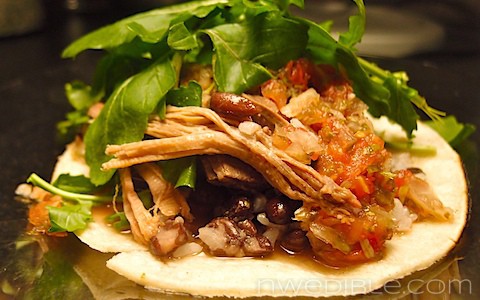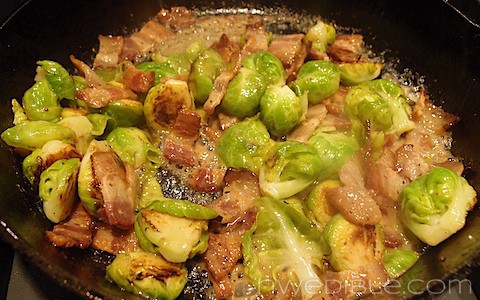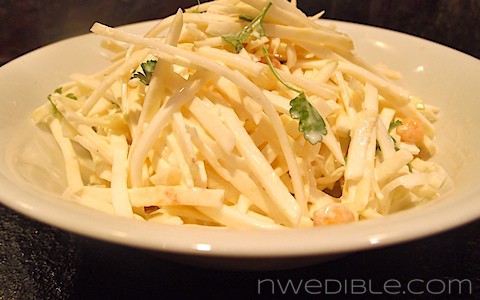Time to get going. The days are stretching out, gardeners can feel spring reaching out to take hold of the vegetable plot. February is the month in the Maritime Northwest when you begin to begin, and by now most of us have recovered enough from September that we are eager to get going.
Plan & Purchase:
By now you should have a pretty good idea what you will be growing, and where you will be growing it. If you’re still finalizing your garden plan, think about crop rotation so you aren’t growing the same crop in one spot year after year. Also consider mature height of your plants, and keep the tall stuff to the North of the short stuff. If you want to get formal in your companion planting, check out this excellent chart from Urban Farm Magazine. If you want to be informal about companion planting, just do what I do and shove calendula and nasturtium and marigold seeds everywhere and let nature take it from there.
Now’s the time to order perennial plants like rhubarb and asparagus, and this is a good time to find bare-root fruit trees, bushes and canes at nurseries. They should be planted as soon as they arrive, and no later than mid-March. For best selection, order your seed potatoes at the beginning of the month, too.
- Rhubarb Crowns
- Asparagus Crowns
- Bare Root Fruit Trees
- Bare Root Fruit Bushes
- Bare Root Cane Fruit & Vines
- Seed Potatoes
Start Indoors:
- Asparagus – if you want to try growing asparagus from seed, you have to start at the beginning of February. The seeds can take almost a month to germinate. Personally, I’d wait a month or two and buy 1 year old crowns from a good nursery or mail order seed company.
- Artichokes – I like Green Globe and Violetta.
- Broccoli – early varieties should be started under lights this month for planting out under a cloche at the beginning of April. I like Territorial Seed’s Hybrid Broccoli Blend, I get a longer, staggered harvest from a single sowing. Packman or Express are also good early varieties. I’ll also sow some Broccoli Raab.
- Brussels Sprouts – early varieties should be started under lights mid-month for planting out under a cloche at the beginning of April. I prefer Brussels Sprouts as a cool season crop, and will start them in June to mature in mid-September for harvest through fall and winter. If you want to give them a go as a Spring/Summer crop, pick a fast-maturing variety like Franklin and watch the aphids.
- Cabbage – early varieties should be started under lights mid-month for planting out under a cloche at the beginning of April. Try Derby Day or Parel green cabbages and Primero or Ruby Ball red cabbage. Any variety with 80 days-to-maturity or less according to Territorial will be a good Spring cabbage. The ones that take over 100 days to mature are generally better keepers and should be sown for Fall and Winter holding.
- Cauliflower – early varieties should be started under lights mid-month for planting out under a cloche at the beginning of April. Try Snow Crown or Amazing.
- Kohlrabi – Kolibri is a good variety for spring, but I like this crop better and find it easier to grow for fall.
- Chard, Collards and Kale – if you want early cooking greens you can start them now. If your space under lights is limited, wait and sow them out under a cloche next month.
- Hardy Herbs – now is the time to sow seed for parsley, lemon verbena, chives, fennel, borage, chamomile, chervil and johnny-jump-ups (yes, they’re edible!)
- Salad Greens – Aim for a salad green sowing every month. New month? New sowing of lettuce, etc. That’ll give you edible salad greens in some stage of growth through October. It’s still quite early, so stick to the cool-weather cultivars. I like Victoria and Little Gem Romaine, but sowing a few square feet lightly with a lettuce or mesclun blend is probably the easiest way to grow salad greens.
- Spinach – Just like the other salad greens: new month, more spinach. Olympia and Regal are good for this time of year, but spinach bolts quick as a wink, so don’t wait on harvesting it.
- Onions & Summer Leeks – You did these guys last month, right? If not, you’ll want to jump on it now or we’ll be buying Walla Walla sets at the nursery together. Roxton and King Richard are good summer variety leeks. You’ll want long-day or day-neutral onion varieties if you’re in the Northwest. No short-days.
- Peas – start these inside in a length of gutter, or sow them out and cover with a sheet of clear plastic to keep them warm and not-soggy until they germinate. Then cloche them and plan for early peas.
- Tomatoes – depending on how much work you are willing to put into your tomatoes, you can start them in February with plans to up-pot to gallons if necessary and transplant to a pre-warmed, tunnel-cloched bed in late April or early May, depending on weather. If you just don’t want to put that much work into it, wait a month.
- Hot Peppers and Sweet Peppers – I start these at the same time as tomatoes, knowing they will need more babying than maters and will get a spot in the greenhouse. I have had good luck with Gypsy sweet peppers.
Sow & Plant Outside:
As long as the ground isn’t frozen or waterlogged, fruiting trees, bushes and perennials can all be planted out.
- Peas – George Washington’s birthday (2/21) is the traditional time to sow peas. Anyway, if the soil has warmed up and isn’t waterlogged, and if you didn’t sow peas indoors, the end of February is a good time to get them in the ground. If the soil still seems really cold and wet, wait a few more weeks or cover with a piece of clear plastic to keep the heat in the soil and the rain off it.
- Favas – Direct sow anytime. I like Broad Windsor.
- Garlic – You don’t have to do this because you got your garlic in last fall so it’s already showing 6 or 7 inches of shoot, right? Right? Oh, well, not to worry! Just stick some in now. Your garlic heads will be smaller but you’ll still have homegrown garlic.
- Salad Greens, Spinach, Asian Greens & European Greens – sow out the hardiest greens under cloche for the earliest possible direct seeded new crop greens. If the weather sucks they’ll take their sweet time germinating so starting indoors and transplanting is more reliable.
- Radishes
- Onion Sets – for early green onions, you can plant sets now and use them before they bulb.
- Bare root fruit trees – these should be put into previously prepared ground while still dormant.
- Bare root fruit bushes (currants, gooseberries, blueberries, etc.) – just like the trees, get these in the ground while still dormant.
- Cane fruits (blackberries, raspberries, etc.) – available bare root now.
- Rhubarb crowns – these can be had by dividing established plants or purchased at a good nursery.
- Horseradish roots – these can be invasive! It’s a good idea to plant them in a very large container sunk into the ground to control their roaming.
Harvest:
- Brussels Sprouts
- Overwintering Cabbage
- Carrots & Parsnips
- Kale & Collards
- Overwintering Cauliflower
- Sprouting Broccoli
- Winter Kohlrabi
- Chard
- Leeks
- Turnips & Rutabagas
- Protected Salad Greens, Asian Greens and Euro Greens
- Jerusalem Artichokes
- Stored Winter Squash
- Stored Potatoes
- Celeriac
“Why are there random pictures of food in this post,” you might ask. “Why not!?” would be my only response. Now, who’s excited to get growing?
0


Suddenly, I am excited and overwhelmed. I thought I was doing good because my tomatoes had just sprouted, and I ordered my seed potatoes. Suddenly there is so much more to think about. I’m trying to specialize. I repeat, specialize. Limited options for my limited know how. But, I want gypsy peppers and broccoli raab dammit! (and whine, with my cheese).
Great list though. I am scribbling away in my notebook.
Preparing to start tomatoes, peppers and eggplant this week. Also weeding the cover crops as the recent rains have them growing like crazy here in the Northern Sacramento Valley.
Erica, Raintree Nursery (per your recommendation) delivered my apple tree during the snowpolypse. Is it really really REALLY ok to plant it already?
Sarah – what’s your ground like where you are planting the tree *right now*?
Probably the same as yours; kind a mushy. Typical February PNW dirt/grass/weeds.
Plant away. 🙂
Ohhh I’m so excited now! The boy and I went to the post office via sled to pick it up. So much fun!
This is brilliant! Just the kind of information I’ve been looking for. Was debating a cold frame set-up to get things gowing but this gives me a good idea for planning and planting. Now I just need to figure out how to keep the hens out of my beds. ; 0 Thanks!!
Hyla- this is the info I was looking for when I started gardening and couldn’t easilly find. That’s why I started this blog. 🙂 Glad it helps.
I thank you and my little garden thanks you for the timely information.
Keep up the good work.
Gaah. I’m just getting my seed order in and hesitating to push the “order” button. $250 in seeds/plants, really? Buying asparagus, strawberries, rhubarb, blackberry, raspberry, as plants, the rest as seeds, a seed starting kit and extra plugs and a seed heating mat. Still need to plan the garden and expand it majorly.
My sister is going to look through the packets when I get them and we will probably share and she will reimburse me for some of it.
Just tell me to do it. Please.
Do it, your health has no price 🙂
Happy to help.
Done. I even added some marigolds to help keep the bunnies away from the strawberries 🙂
I am at the scared stage. After quite a good year last year, except blight making me cry, in front of my mother in law :-), we are expanding again and have now got a green house. Lovely husband seems to think this will bring about great things. Apart from growing peppers and tomatoes in it, I didnt have much planned. Aaargh.
Anyways, planting chart is on the fridge, seeds are sorted into months. List of things to grow is written. Small pile of things that must be planted this month is on the counter top. And so it starts….
I am ready to shop this weekend.
I will plant and sow and what happens happens.
The only thing that Worries me are the damn squirrels and raccoons. How do you keep them out. The squirrels just dug up and broke some broccoli plants while looking for their acorns.